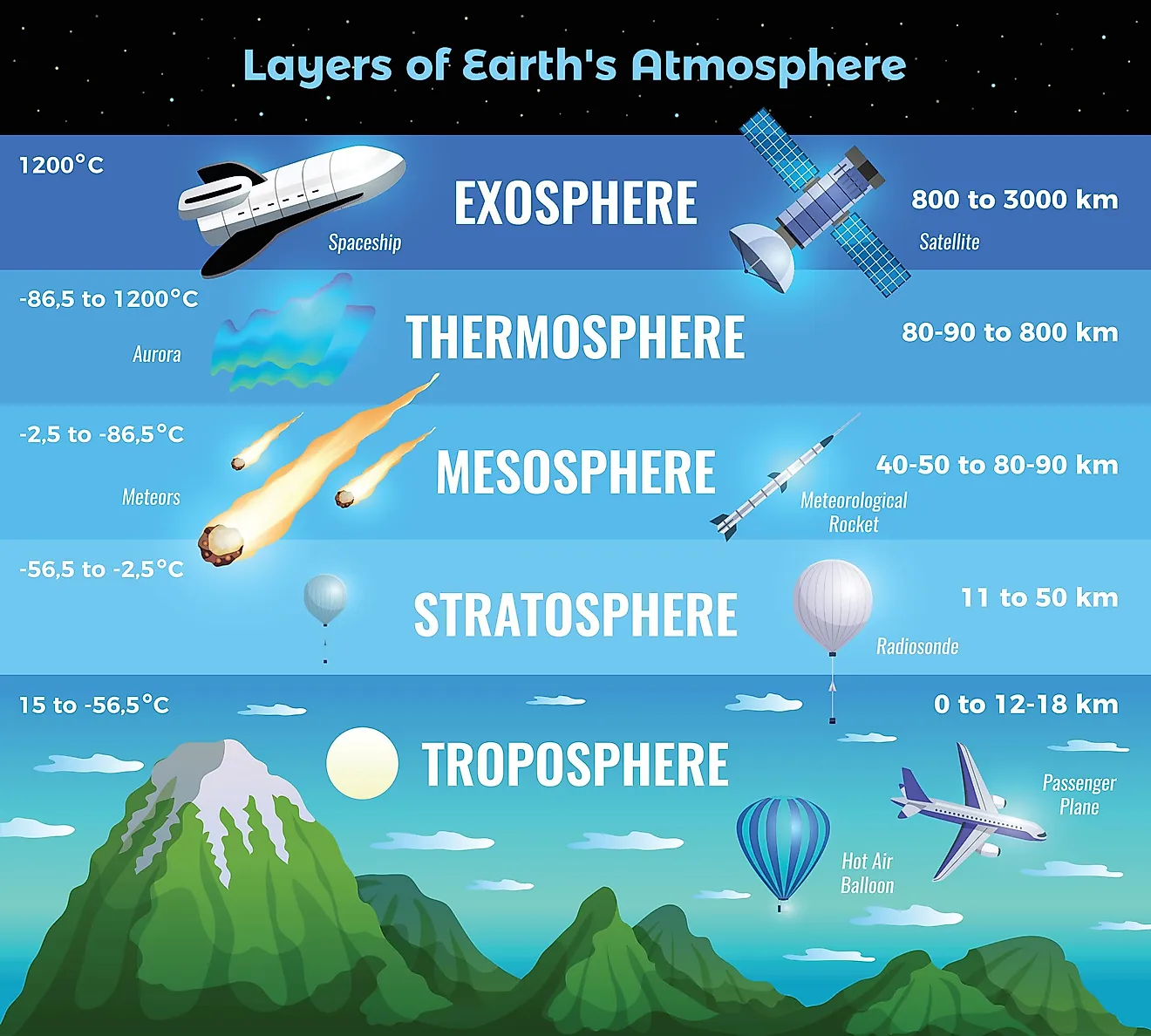 The troposphere is the lowest atmospheric layer and contains most of the air mass and weather. Temperatures generally decrease with height here, promoting vertical mixing and cloud formation.
The troposphere is the lowest atmospheric layer and contains most of the air mass and weather. Temperatures generally decrease with height here, promoting vertical mixing and cloud formation. In tropical regions strong convection elevates the tropopause to higher altitudes, typically around 16–18 km. This is higher than mid-latitudes and polar values.
In tropical regions strong convection elevates the tropopause to higher altitudes, typically around 16–18 km. This is higher than mid-latitudes and polar values. Cold polar air leads to a much lower tropopause, around 8–10 km. Less convection and lower temperatures keep the layer shallower than in the tropics.
Cold polar air leads to a much lower tropopause, around 8–10 km. Less convection and lower temperatures keep the layer shallower than in the tropics. Warmer surfaces produce stronger convective uplift, which pushes the tropopause upward. Thus regions with higher surface temperatures tend to have a higher tropopause.
Warmer surfaces produce stronger convective uplift, which pushes the tropopause upward. Thus regions with higher surface temperatures tend to have a higher tropopause. Tropopause height varies primarily with latitude—highest in the tropics and lowest at the poles—due to differences in temperature and atmospheric circulation.
Tropopause height varies primarily with latitude—highest in the tropics and lowest at the poles—due to differences in temperature and atmospheric circulation. At a given upper-tropospheric height, polar regions are typically colder than mid-latitudes or the tropics because of weaker solar heating and colder air masses.
At a given upper-tropospheric height, polar regions are typically colder than mid-latitudes or the tropics because of weaker solar heating and colder air masses. Heat from Earth’s surface. The atmosphere is mainly heated from below, not directly by sunlight. Solar radiation passes through the air and warms the Earth's surface. The surface then re-emits this energy as infrared (heat), which warms the air above through conduction, convection, and radiation. In contrast, only a small part of the Sun’s energy is absorbed directly by the atmosphere or from above, so options A and C are incorrect. That’s why surface heat, not direct sunlight, is the primary source of atmospheric warming.
Heat from Earth’s surface. The atmosphere is mainly heated from below, not directly by sunlight. Solar radiation passes through the air and warms the Earth's surface. The surface then re-emits this energy as infrared (heat), which warms the air above through conduction, convection, and radiation. In contrast, only a small part of the Sun’s energy is absorbed directly by the atmosphere or from above, so options A and C are incorrect. That’s why surface heat, not direct sunlight, is the primary source of atmospheric warming.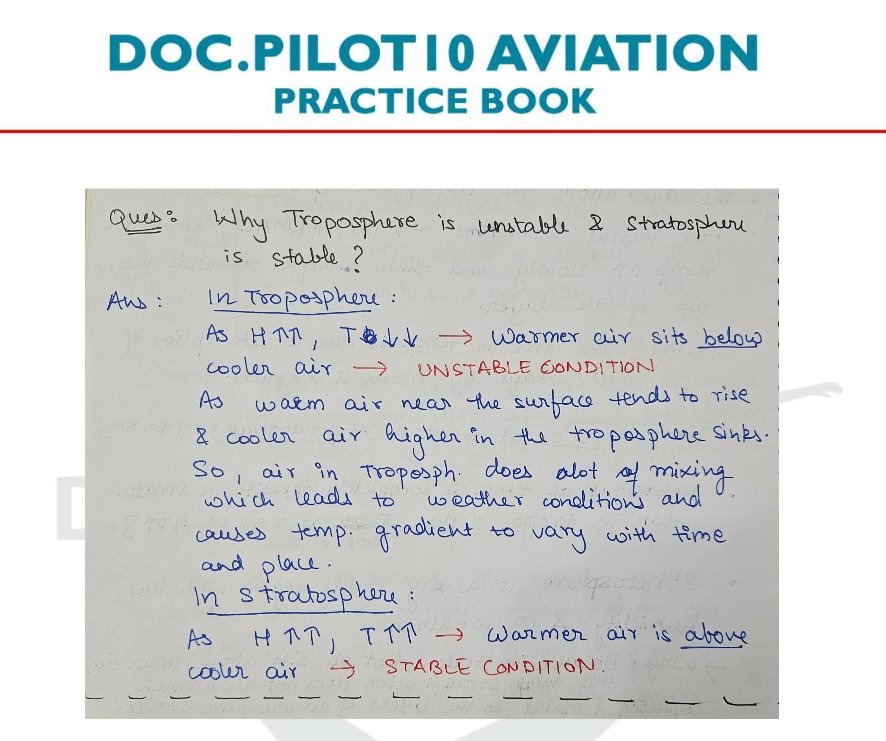 Because it is heated from the surface, the troposphere is often unstable or conditionally unstable, allowing vertical motion essential for cloud and storm development.
Because it is heated from the surface, the troposphere is often unstable or conditionally unstable, allowing vertical motion essential for cloud and storm development. The stratosphere warms with height due to ozone absorbing UV radiation; this inversion suppresses vertical mixing, so the layer is stable.
The stratosphere warms with height due to ozone absorbing UV radiation; this inversion suppresses vertical mixing, so the layer is stable. The stratosphere typically extends from the tropopause up to the stratopause at about 50 km, above which the mesosphere begins.
The stratosphere typically extends from the tropopause up to the stratopause at about 50 km, above which the mesosphere begins. The stratosphere exhibits a temperature inversion (warming with height) and stable conditions due to ozone heating; this distinguishes it from the troposphere below.
The stratosphere exhibits a temperature inversion (warming with height) and stable conditions due to ozone heating; this distinguishes it from the troposphere below.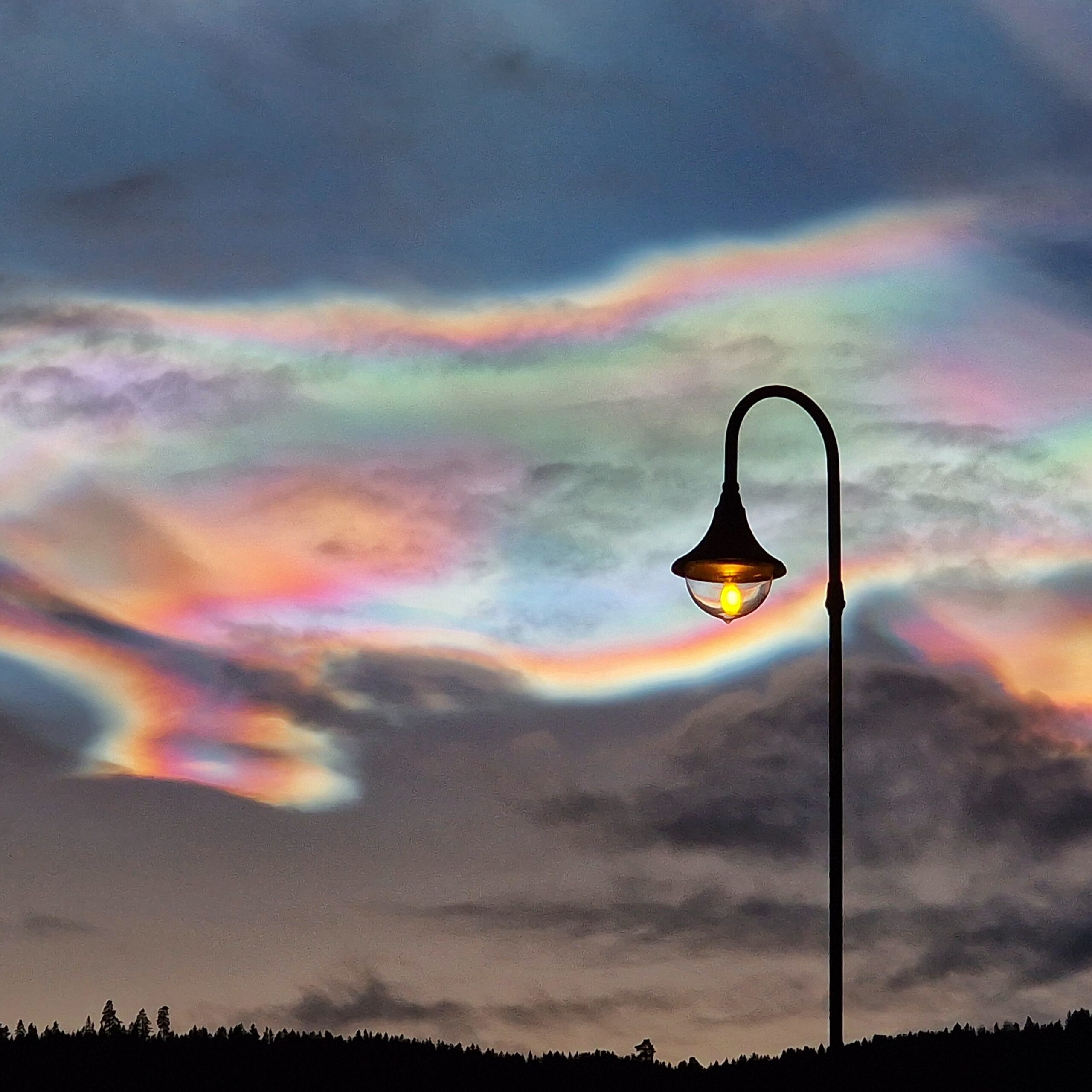 Nacreous clouds form in very cold polar stratospheric conditions during winter, producing iridescent “mother-of-pearl” appearances at high altitudes.
Nacreous clouds form in very cold polar stratospheric conditions during winter, producing iridescent “mother-of-pearl” appearances at high altitudes.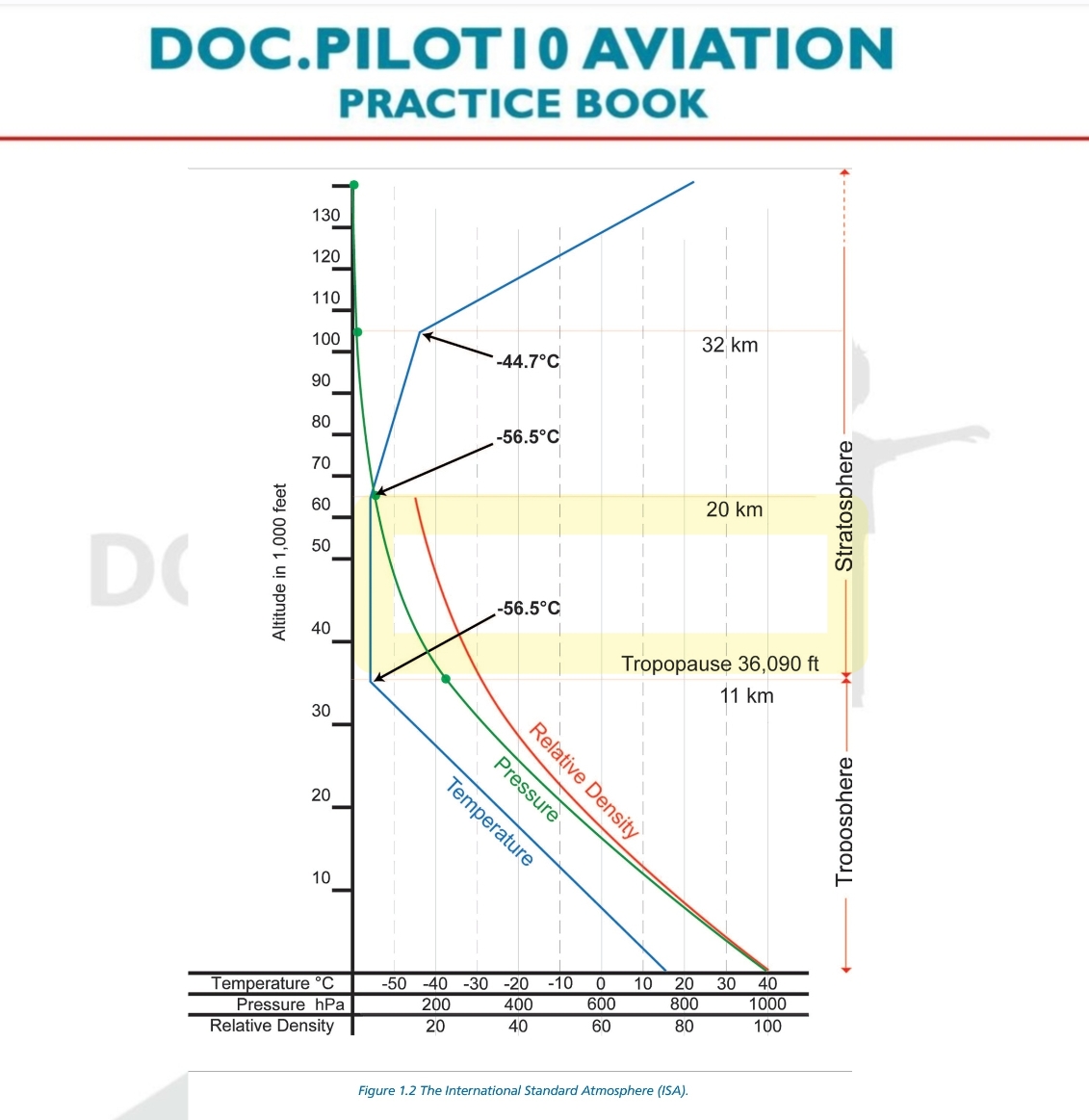 ICAO Standard Atmosphere sets temperature to −56.5°C between 11 km and 20 km, so at 17 km the temperature is −56.5°C.
ICAO Standard Atmosphere sets temperature to −56.5°C between 11 km and 20 km, so at 17 km the temperature is −56.5°C.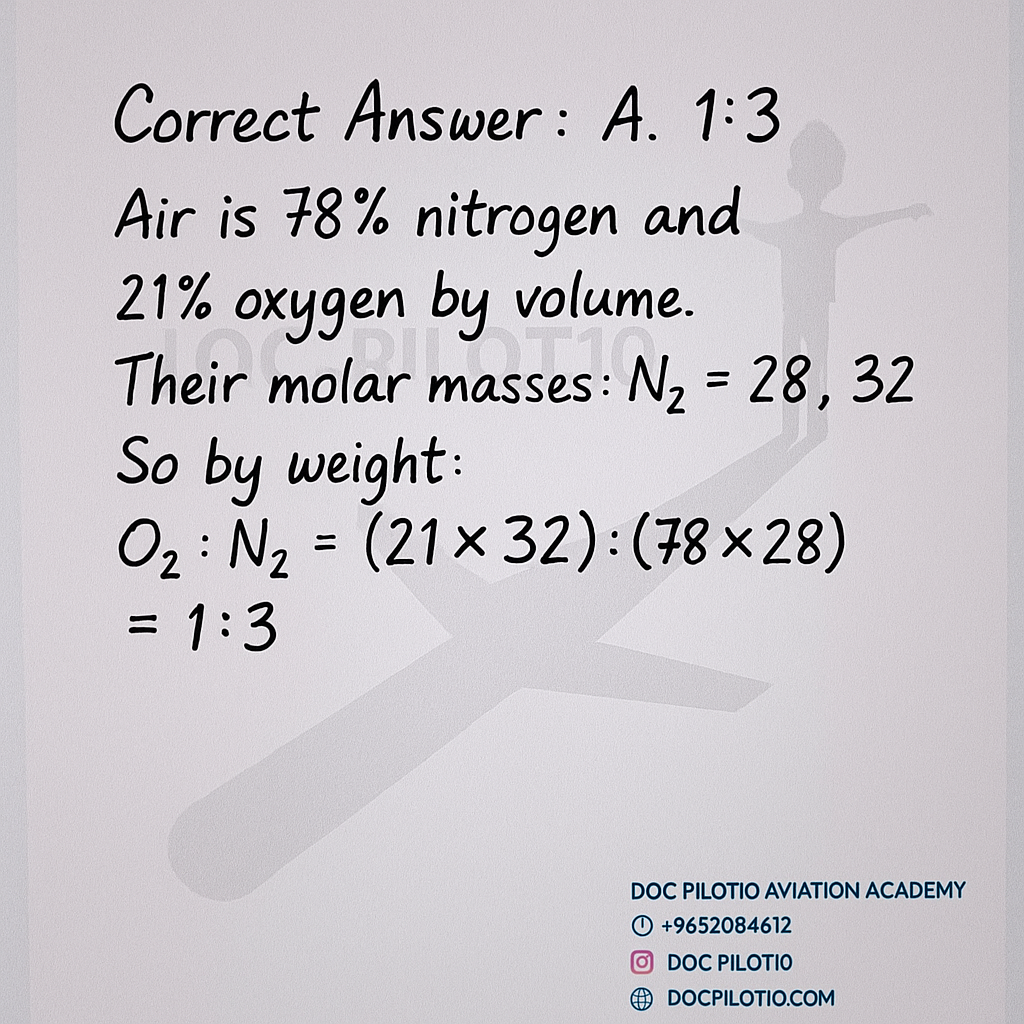 By mass, nitrogen constitutes a larger proportion than oxygen (~75% N₂ vs ~23% O₂ by mass), approximating to about 1:3 (O₂:N₂) by weight.
By mass, nitrogen constitutes a larger proportion than oxygen (~75% N₂ vs ~23% O₂ by mass), approximating to about 1:3 (O₂:N₂) by weight.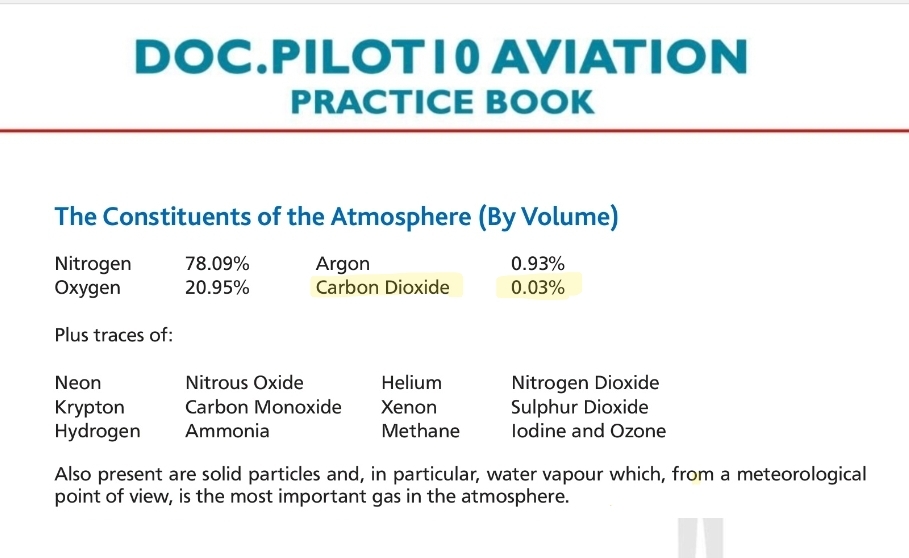 Traditional exam values list atmospheric CO₂ around 0.03% (≈300 ppm). Modern measurements are higher, but 0.03% is commonly used in older question banks.
Traditional exam values list atmospheric CO₂ around 0.03% (≈300 ppm). Modern measurements are higher, but 0.03% is commonly used in older question banks.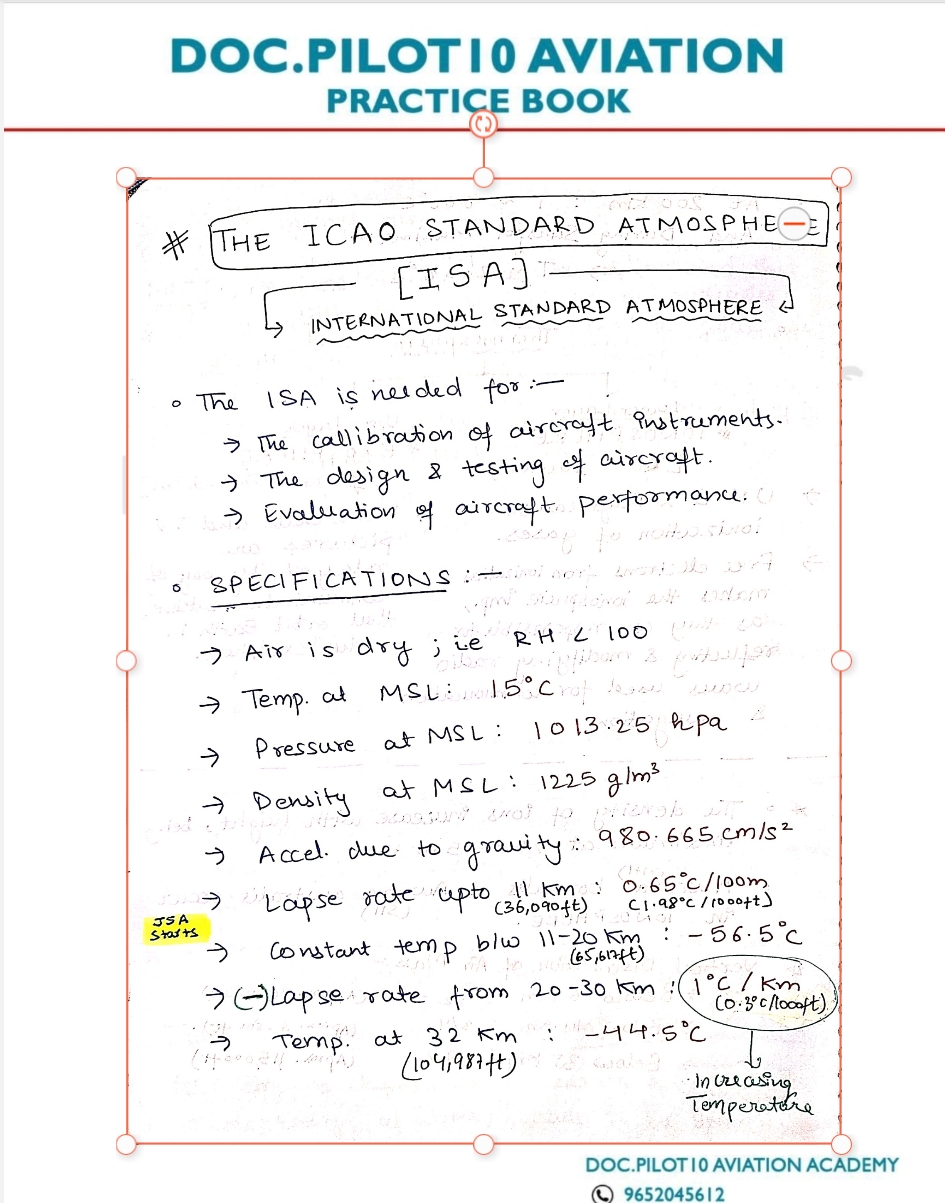 The ICAO Standard Atmosphere specifies mean sea level temperature as +15°C (288.15 K), which is used as a baseline for performance calculations.
The ICAO Standard Atmosphere specifies mean sea level temperature as +15°C (288.15 K), which is used as a baseline for performance calculations.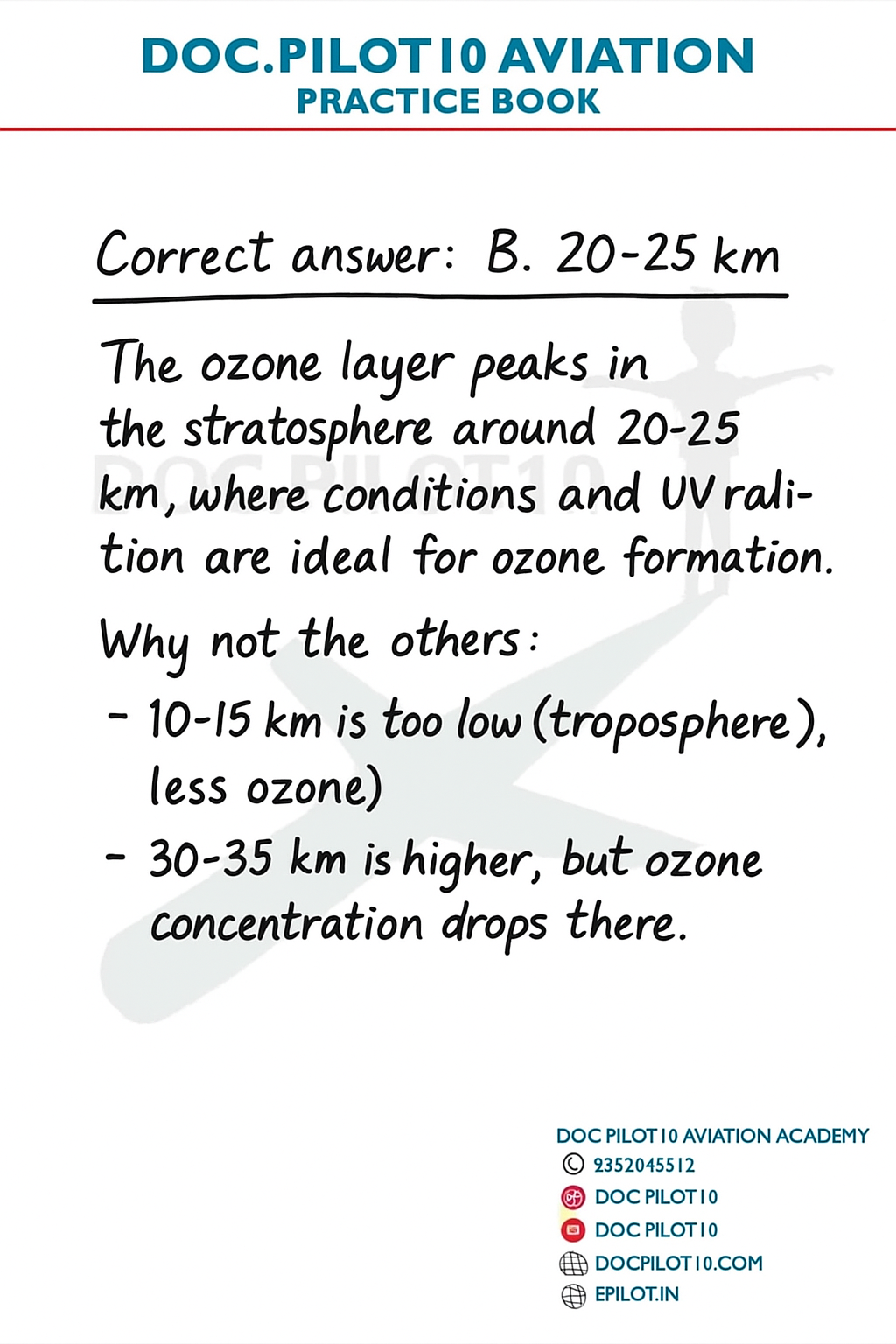 The ozone layer reaches peak concentration in the lower-to-middle stratosphere, roughly between 20 and 25 km, where it effectively absorbs UV radiation.
The ozone layer reaches peak concentration in the lower-to-middle stratosphere, roughly between 20 and 25 km, where it effectively absorbs UV radiation.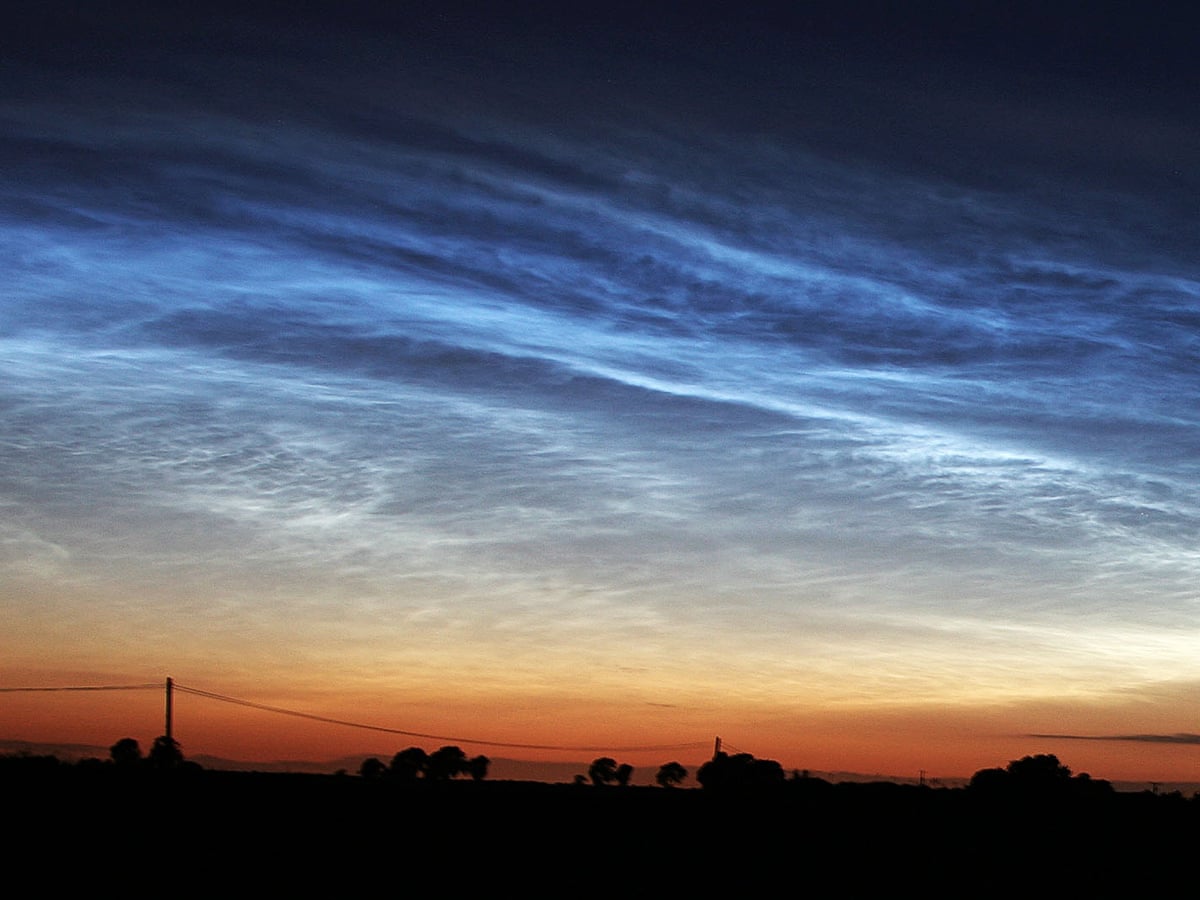 Noctilucent clouds form at very high altitudes near the mesopause (~80–85 km), technically in the region associated with the mesosphere/mesopause.
Noctilucent clouds form at very high altitudes near the mesopause (~80–85 km), technically in the region associated with the mesosphere/mesopause.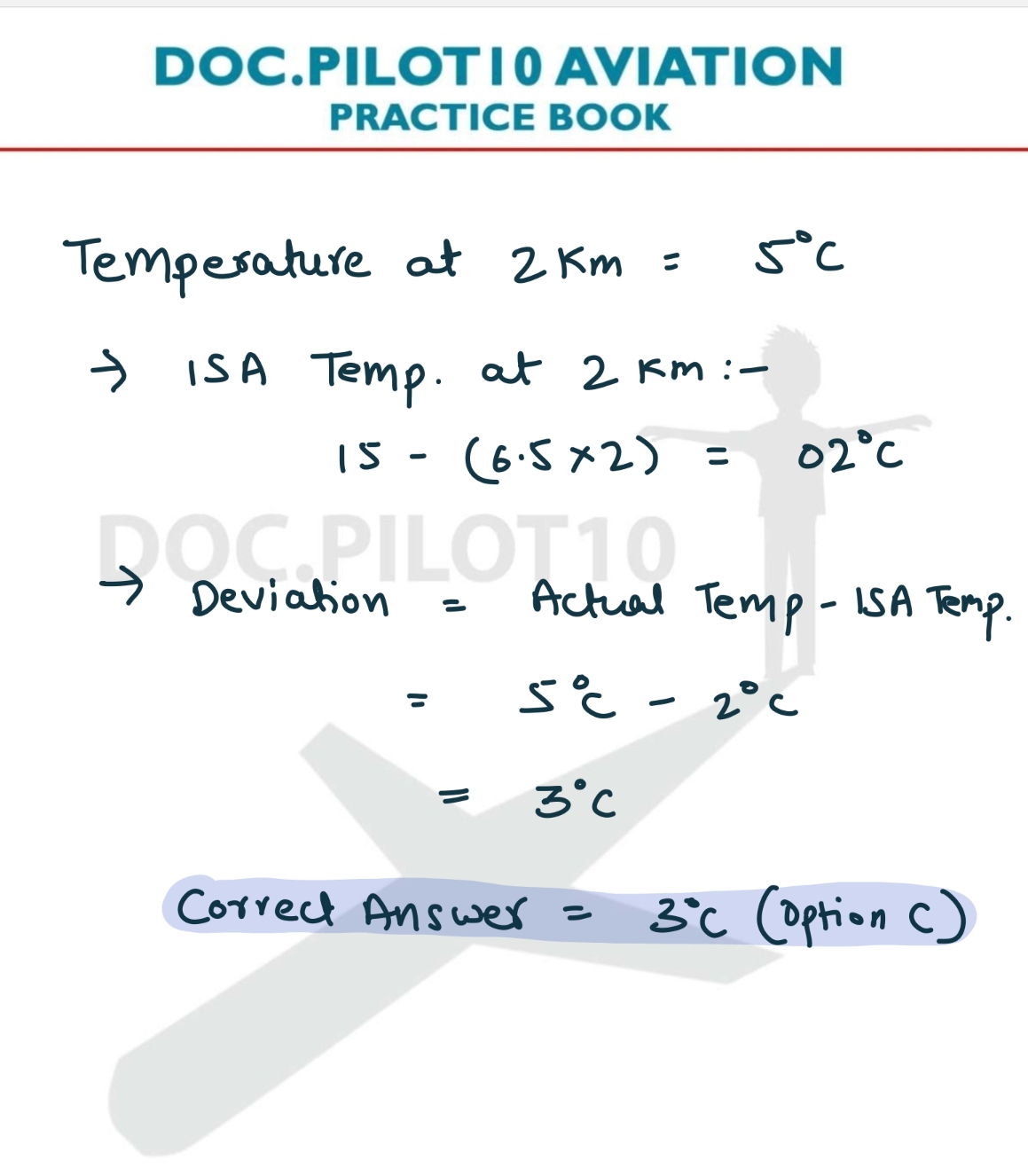 ISA at 2 km: 15 − (6.5 × 2) = +2°C. Actual is +5°C, so deviation = 5 − 2 = +3°C.
ISA at 2 km: 15 − (6.5 × 2) = +2°C. Actual is +5°C, so deviation = 5 − 2 = +3°C.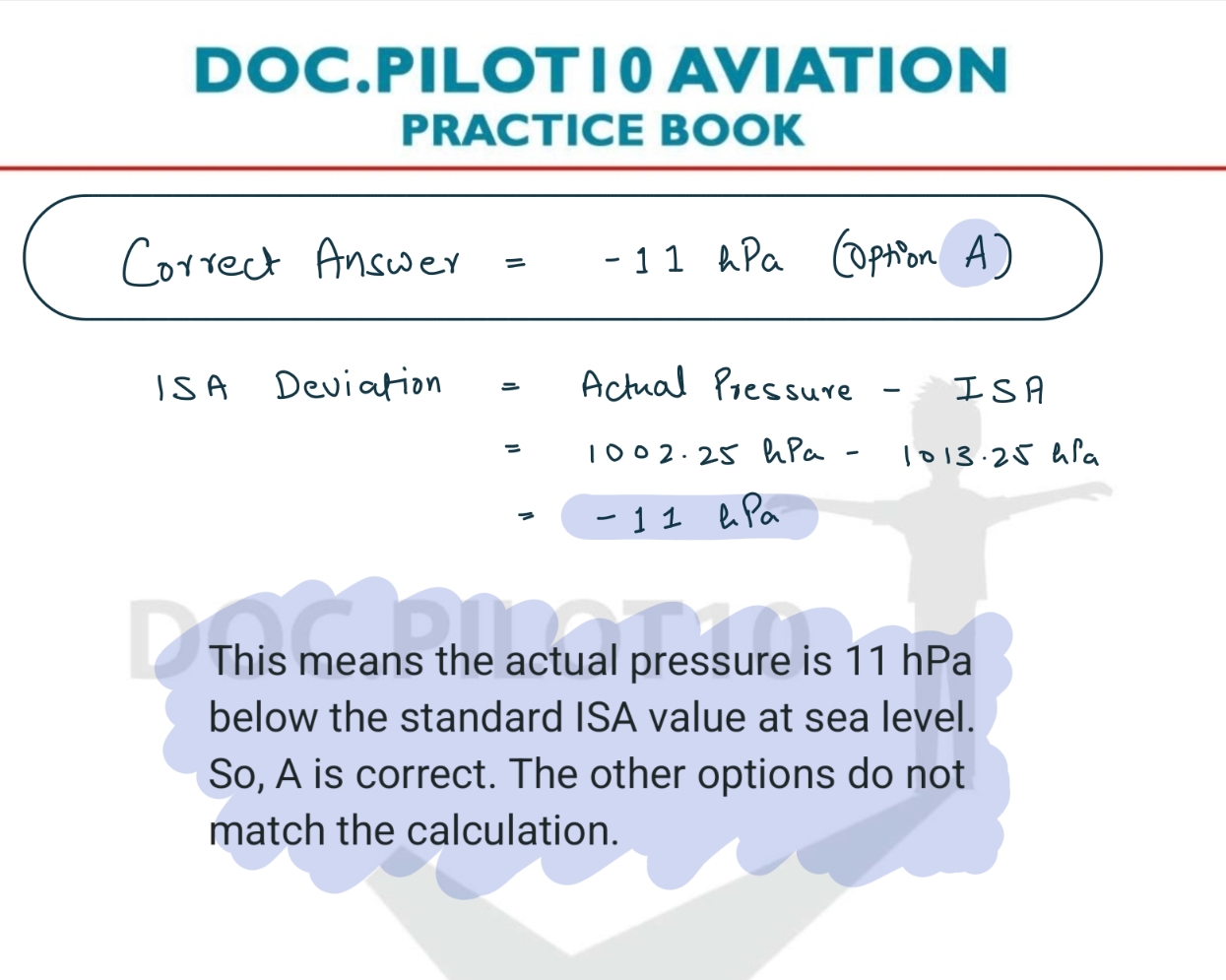 ISA MSL pressure is 1013.25 hPa. Actual minus ISA = 1002.25 − 1013.25 = −11 hPa, indicating a pressure lower than standard.
ISA MSL pressure is 1013.25 hPa. Actual minus ISA = 1002.25 − 1013.25 = −11 hPa, indicating a pressure lower than standard.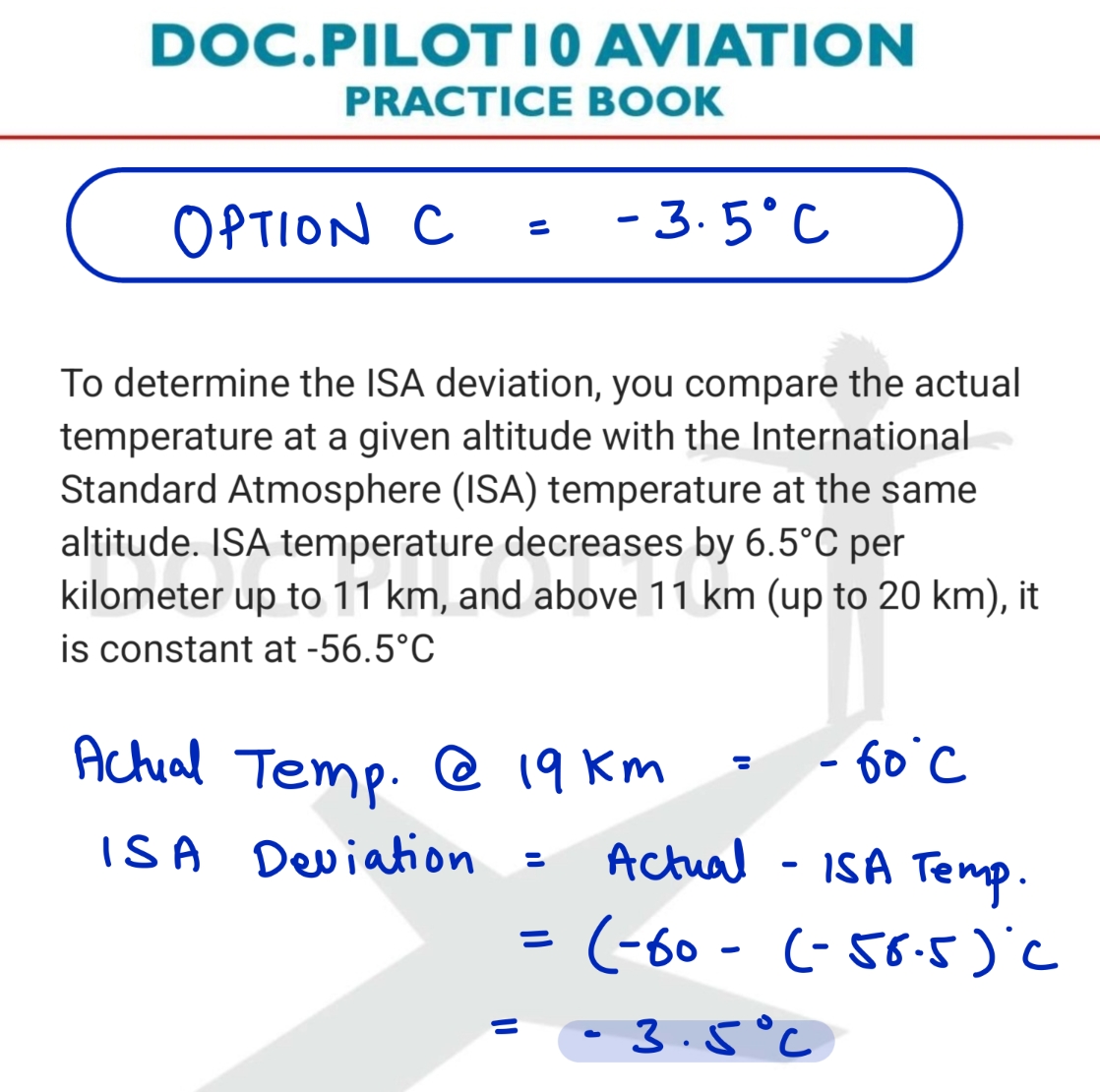 ISA is isothermal at −56.5°C between 11 and 20 km. Deviation = Actual − ISA = −60 − (−56.5) = −3.5°C.
ISA is isothermal at −56.5°C between 11 and 20 km. Deviation = Actual − ISA = −60 − (−56.5) = −3.5°C.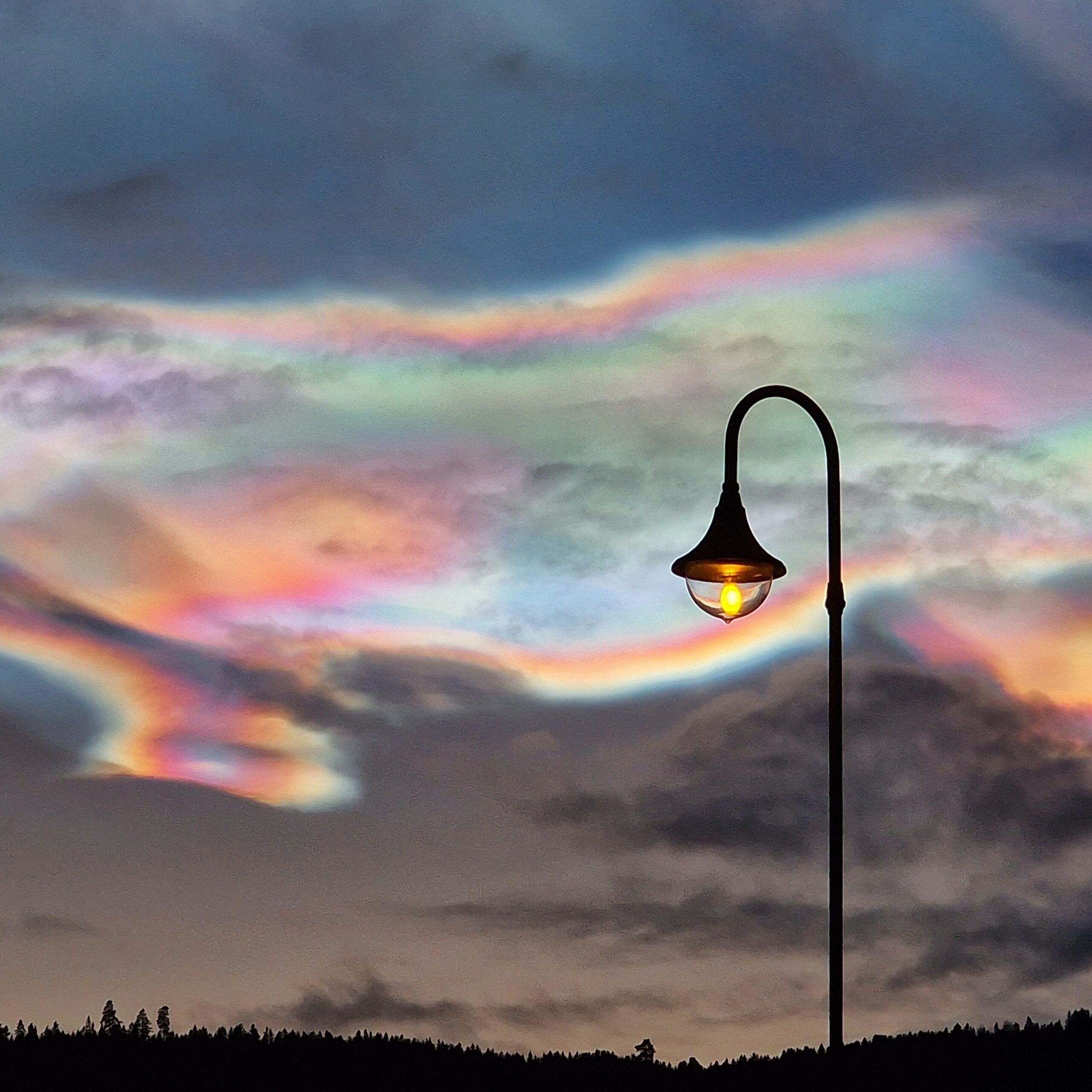 Nacreous clouds, also known as polar stratospheric clouds, form in the upper stratosphere, typically at altitudes of 15-25 km. The correct answer is C: Upper Stratosphere because:
Formation Conditions: These clouds form in extremely cold temperatures (below -78°C), which are found in the polar regions, specifically in the upper part of the stratosphere during winter.
Incorrect Options:
Thermosphere (Option A): Too high in altitude (above 80 km) and too hot for cloud formation.
Mesosphere (Option B): This layer is higher (50-85 km) and has different cloud types, like noctilucent clouds, not nacreous clouds.
Why Upper Stratosphere?: The stratosphere provides the perfect conditions for nacreous clouds due to its temperature and altitude range.
This is why C: Upper Stratosphere is the correct answer..
Nacreous clouds, also known as polar stratospheric clouds, form in the upper stratosphere, typically at altitudes of 15-25 km. The correct answer is C: Upper Stratosphere because:
Formation Conditions: These clouds form in extremely cold temperatures (below -78°C), which are found in the polar regions, specifically in the upper part of the stratosphere during winter.
Incorrect Options:
Thermosphere (Option A): Too high in altitude (above 80 km) and too hot for cloud formation.
Mesosphere (Option B): This layer is higher (50-85 km) and has different cloud types, like noctilucent clouds, not nacreous clouds.
Why Upper Stratosphere?: The stratosphere provides the perfect conditions for nacreous clouds due to its temperature and altitude range.
This is why C: Upper Stratosphere is the correct answer..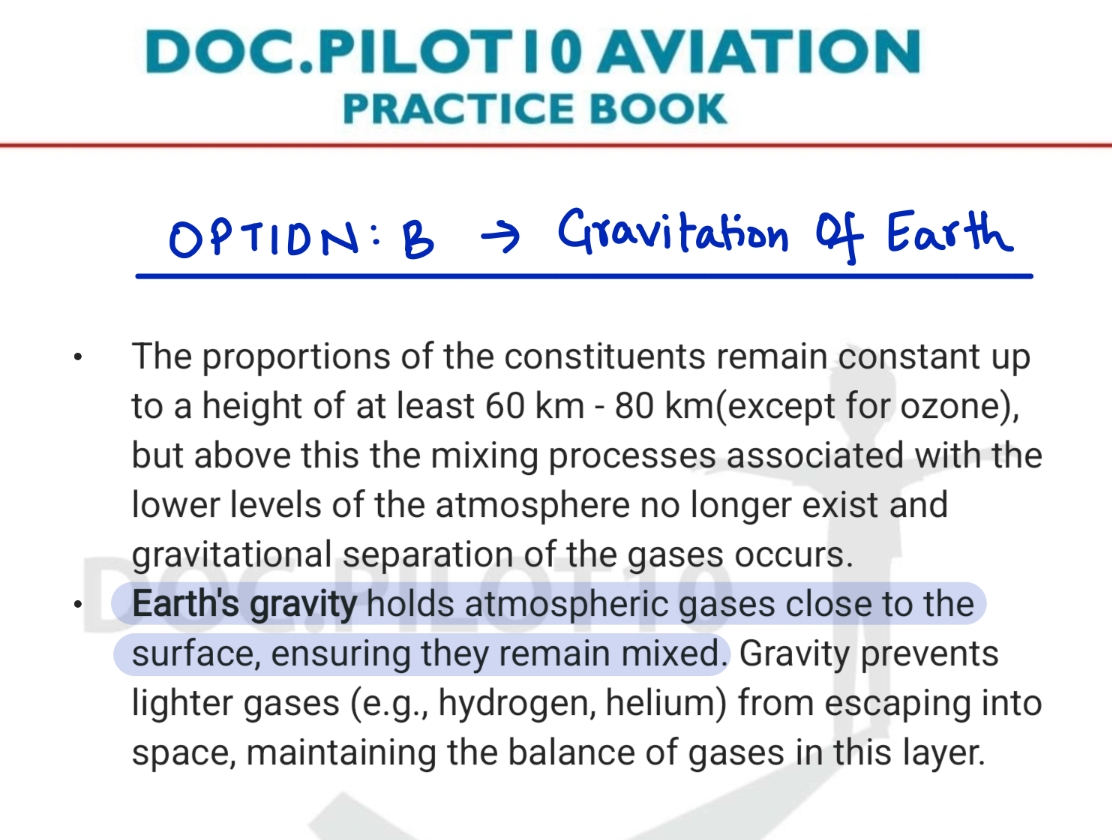 Turbulent mixing and large-scale circulation keep the homosphere well-mixed in composition up to around 80 km; above that molecular diffusion dominates.
Turbulent mixing and large-scale circulation keep the homosphere well-mixed in composition up to around 80 km; above that molecular diffusion dominates.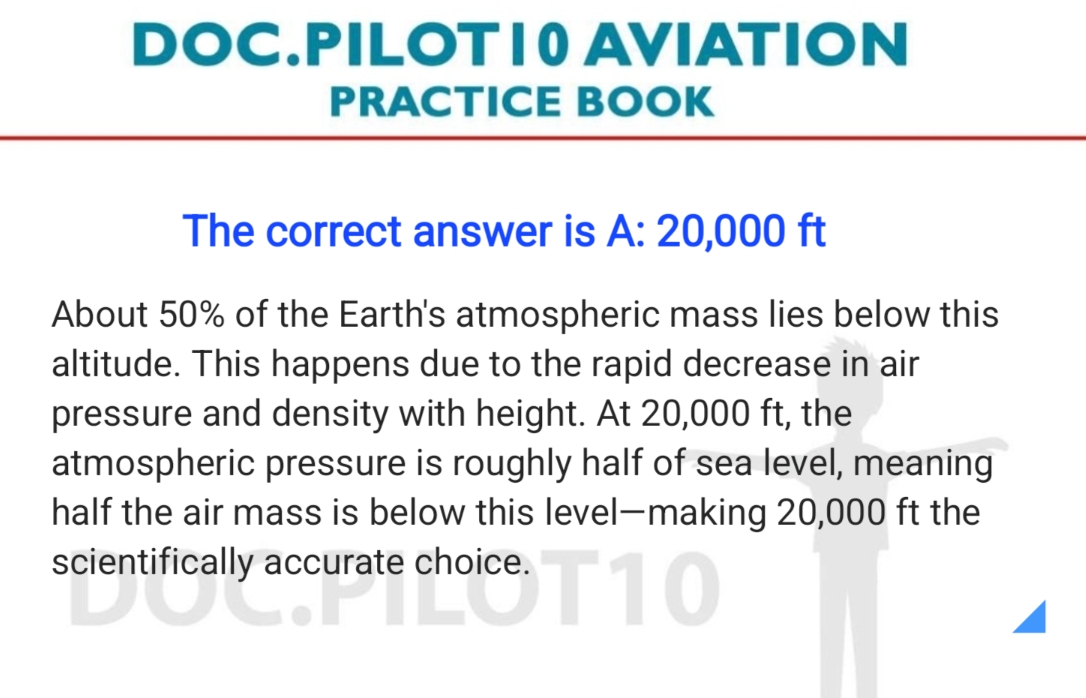 About half the atmosphere’s mass lies below roughly 18,000 ft; among the choices 20,000 ft is the closest common exam benchmark due to exponential pressure decrease.
About half the atmosphere’s mass lies below roughly 18,000 ft; among the choices 20,000 ft is the closest common exam benchmark due to exponential pressure decrease.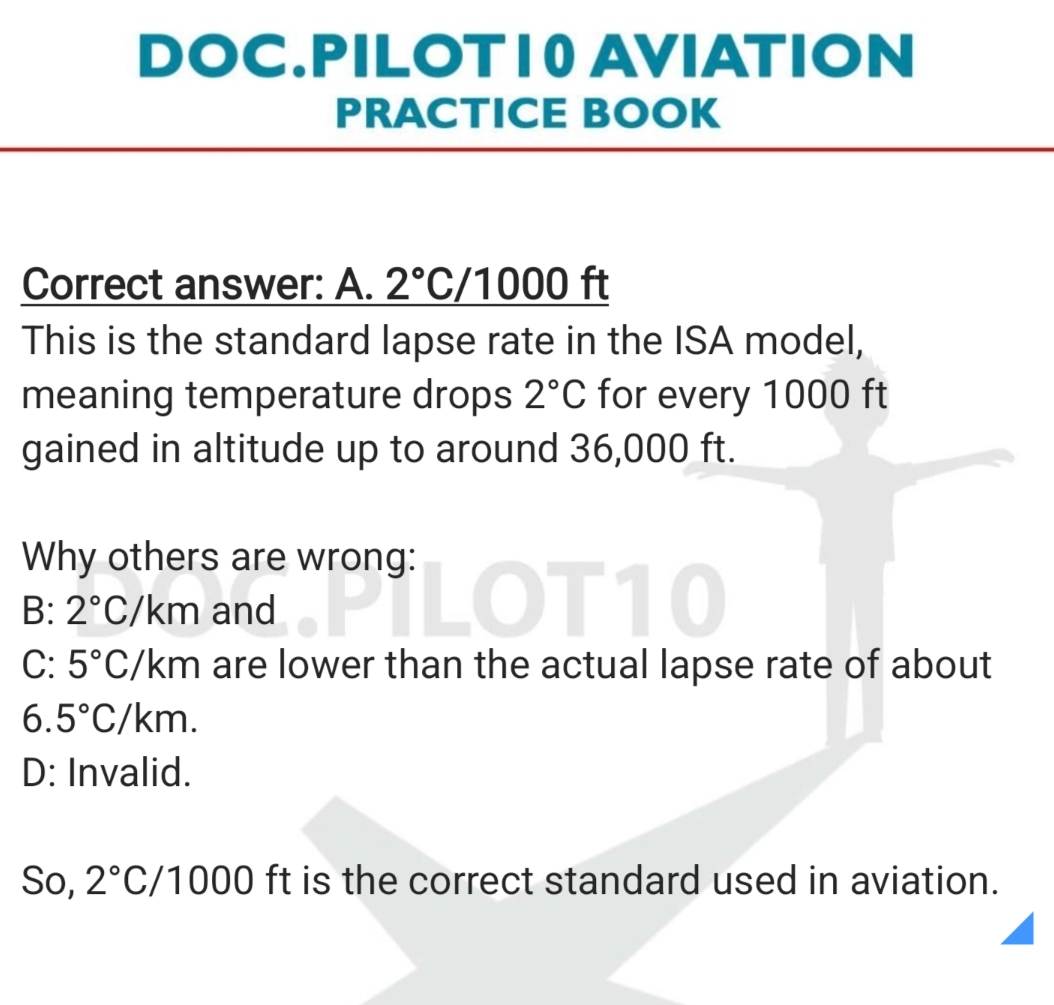 Pilots often use ~2°C per 1000 ft as a practical lapse rate in the troposphere; ISA uses about 6.5°C/km which corresponds to this figure.
Pilots often use ~2°C per 1000 ft as a practical lapse rate in the troposphere; ISA uses about 6.5°C/km which corresponds to this figure. The term “lapse rate” denotes how temperature decreases with altitude; it’s a core concept in atmospheric stability and weather forecasting.
The term “lapse rate” denotes how temperature decreases with altitude; it’s a core concept in atmospheric stability and weather forecasting.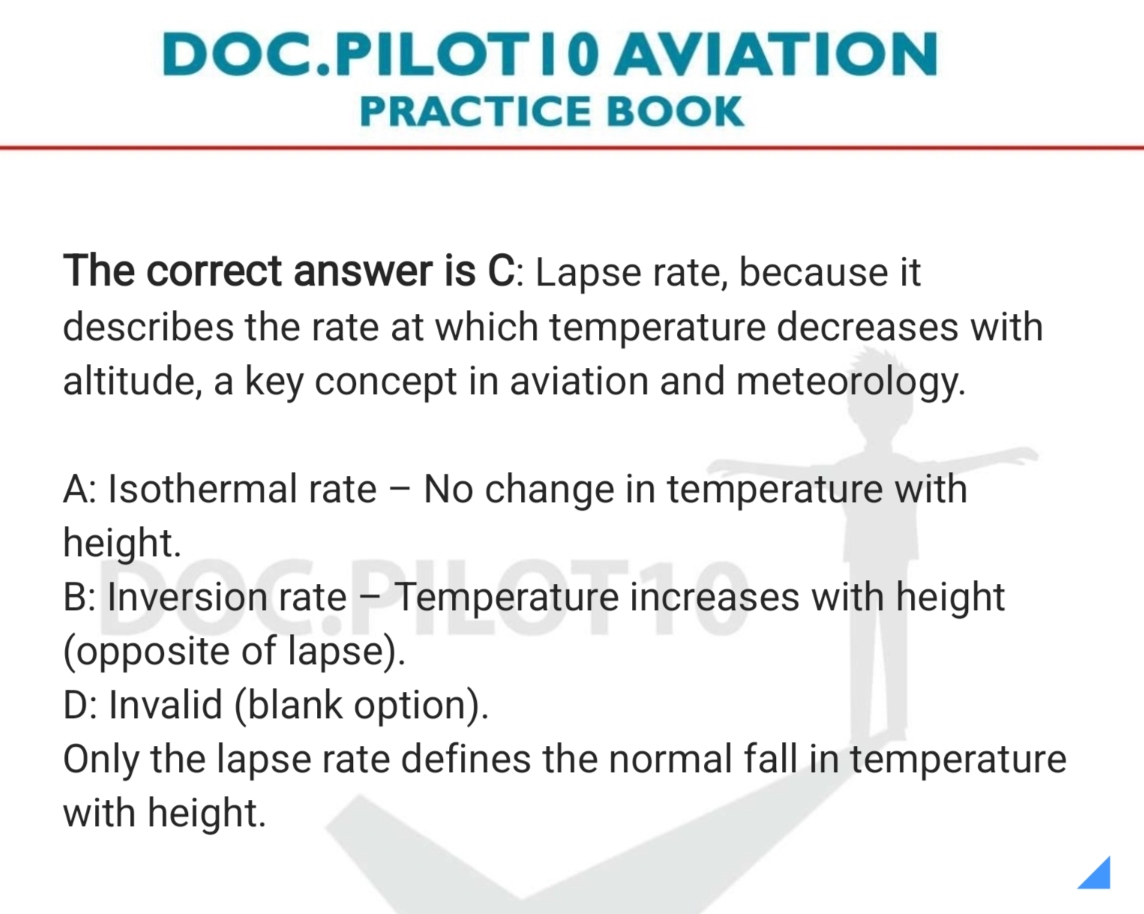 Observed lapse rates vary widely depending on local heating, moisture, and vertical motion; they can be positive, zero, or negative (inversion).
Observed lapse rates vary widely depending on local heating, moisture, and vertical motion; they can be positive, zero, or negative (inversion).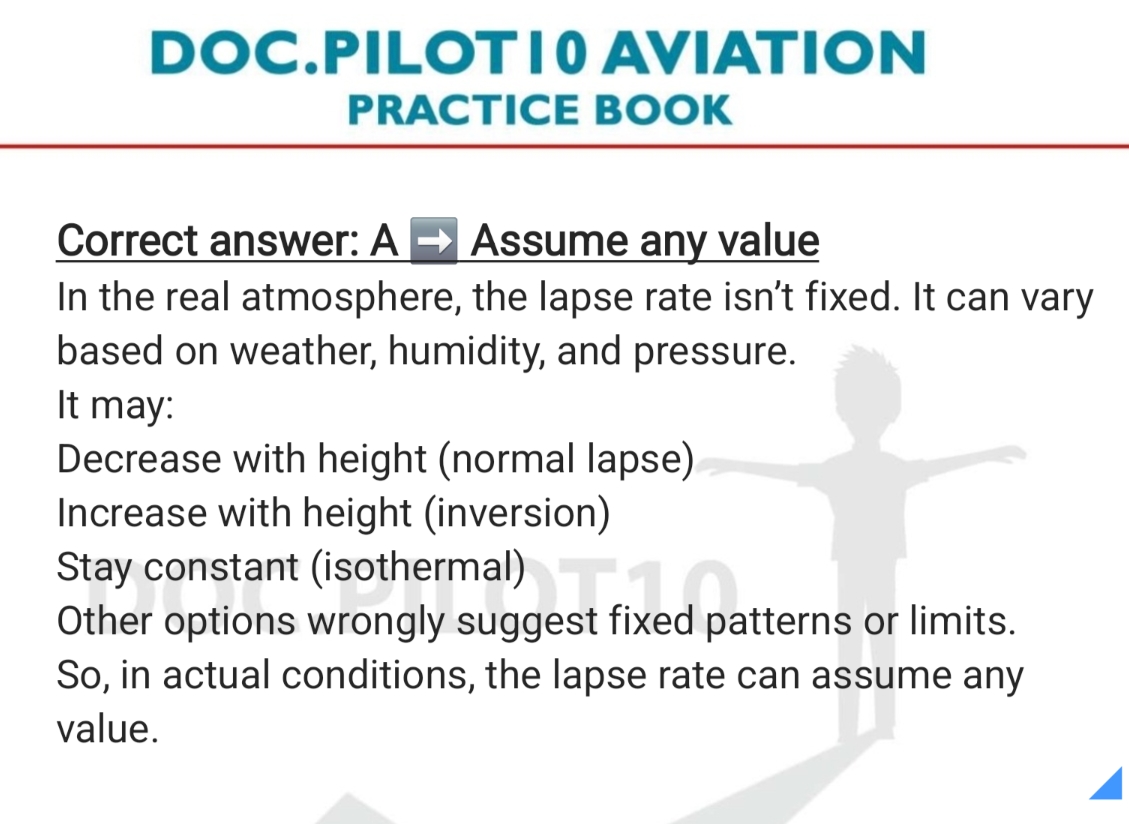 India typically falls within the tropical tropopause region where heights are around 16–16.5 km, higher than mid-latitudes due to stronger convection.
India typically falls within the tropical tropopause region where heights are around 16–16.5 km, higher than mid-latitudes due to stronger convection.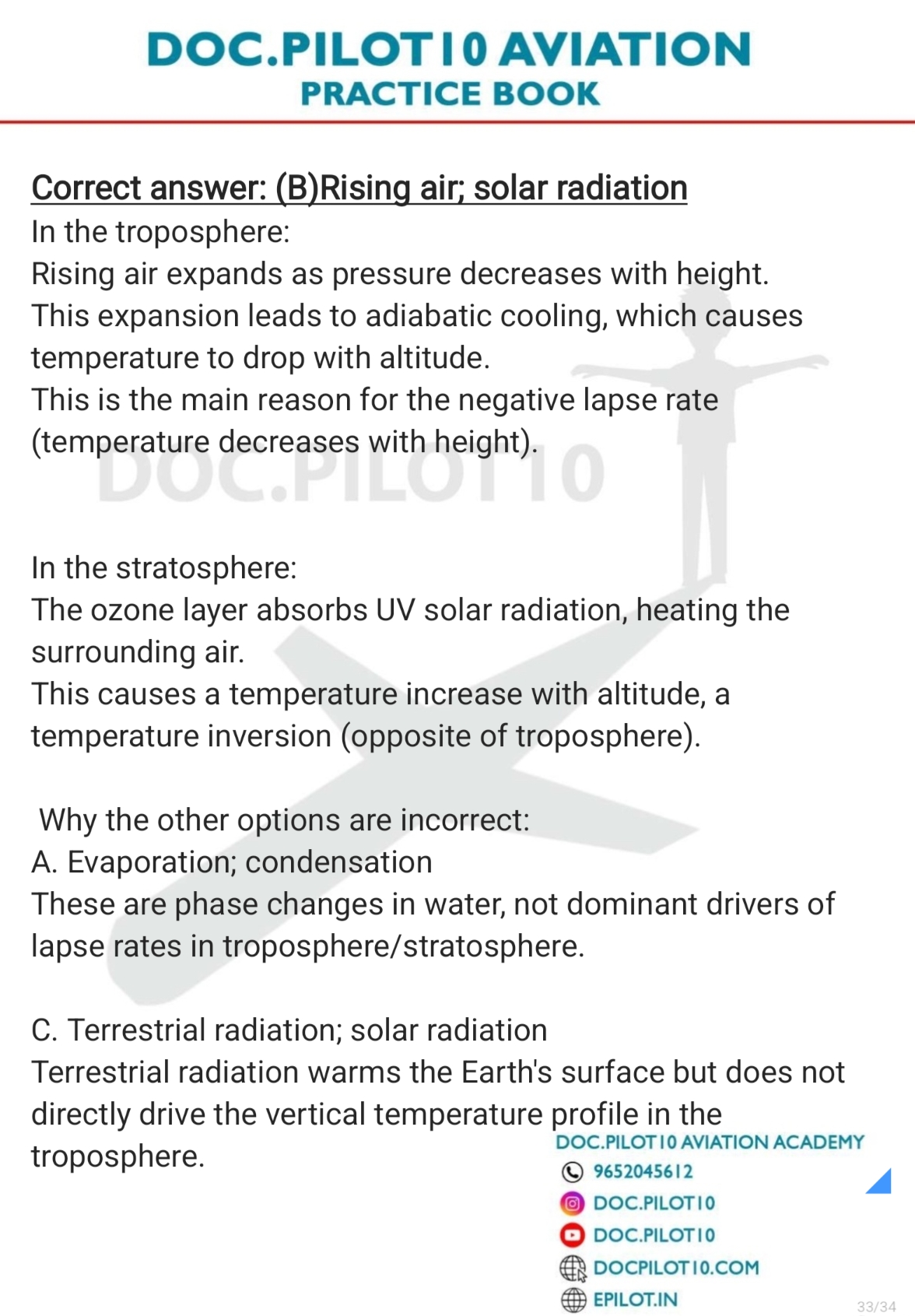 The troposphere is mainly heated from the Earth (terrestrial/infrared radiation) producing a decrease with height; the stratosphere warms from solar UV absorbed by ozone, creating an inversion.
The troposphere is mainly heated from the Earth (terrestrial/infrared radiation) producing a decrease with height; the stratosphere warms from solar UV absorbed by ozone, creating an inversion.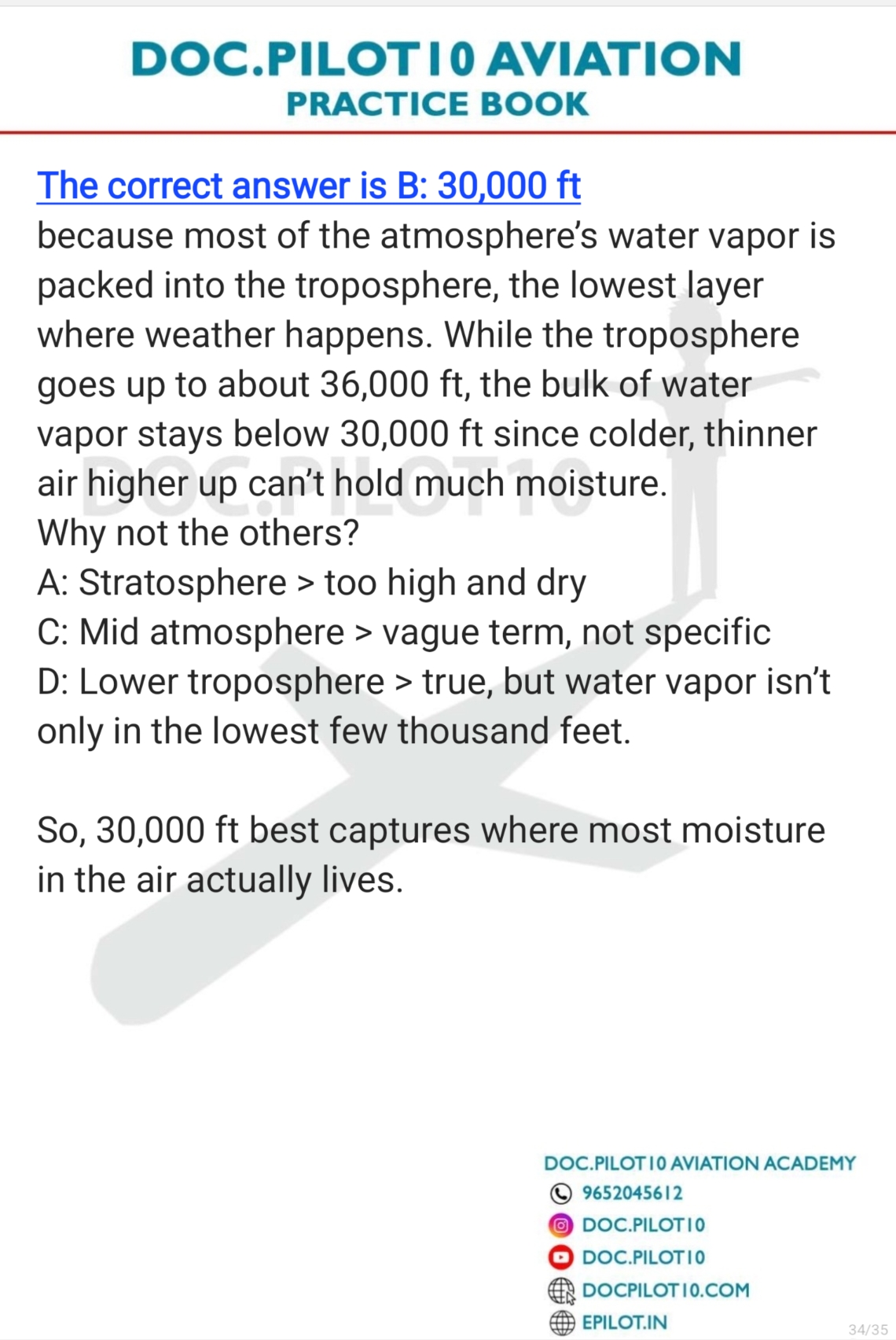 Water vapour is concentrated close to the surface in the lower troposphere where temperature and evaporation support moisture; humidity decreases rapidly with height.
Water vapour is concentrated close to the surface in the lower troposphere where temperature and evaporation support moisture; humidity decreases rapidly with height.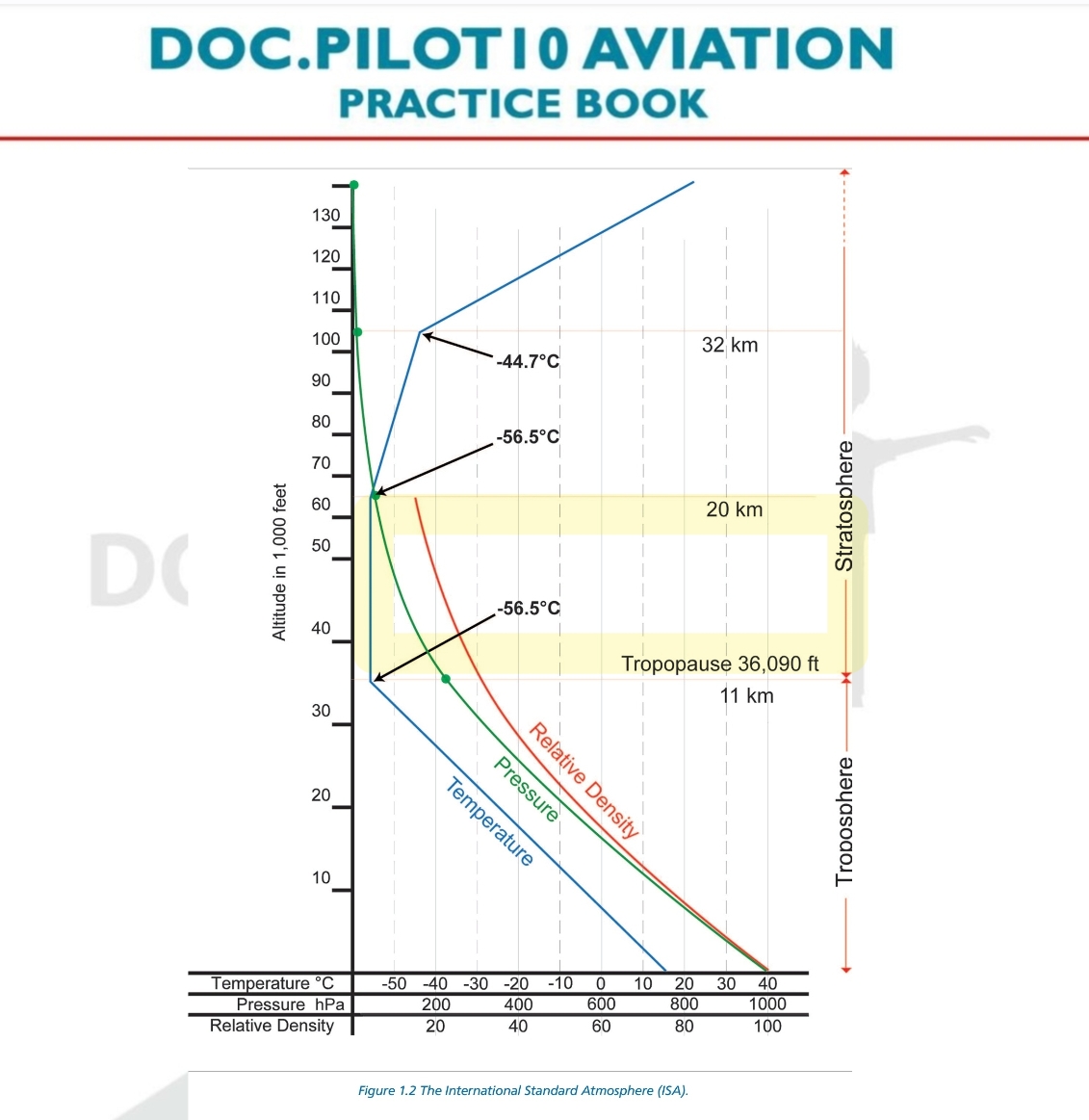 ISA sets a constant temperature of −56.5°C between 11 km and 20 km to simplify standard atmosphere calculations for aviation.
ISA sets a constant temperature of −56.5°C between 11 km and 20 km to simplify standard atmosphere calculations for aviation.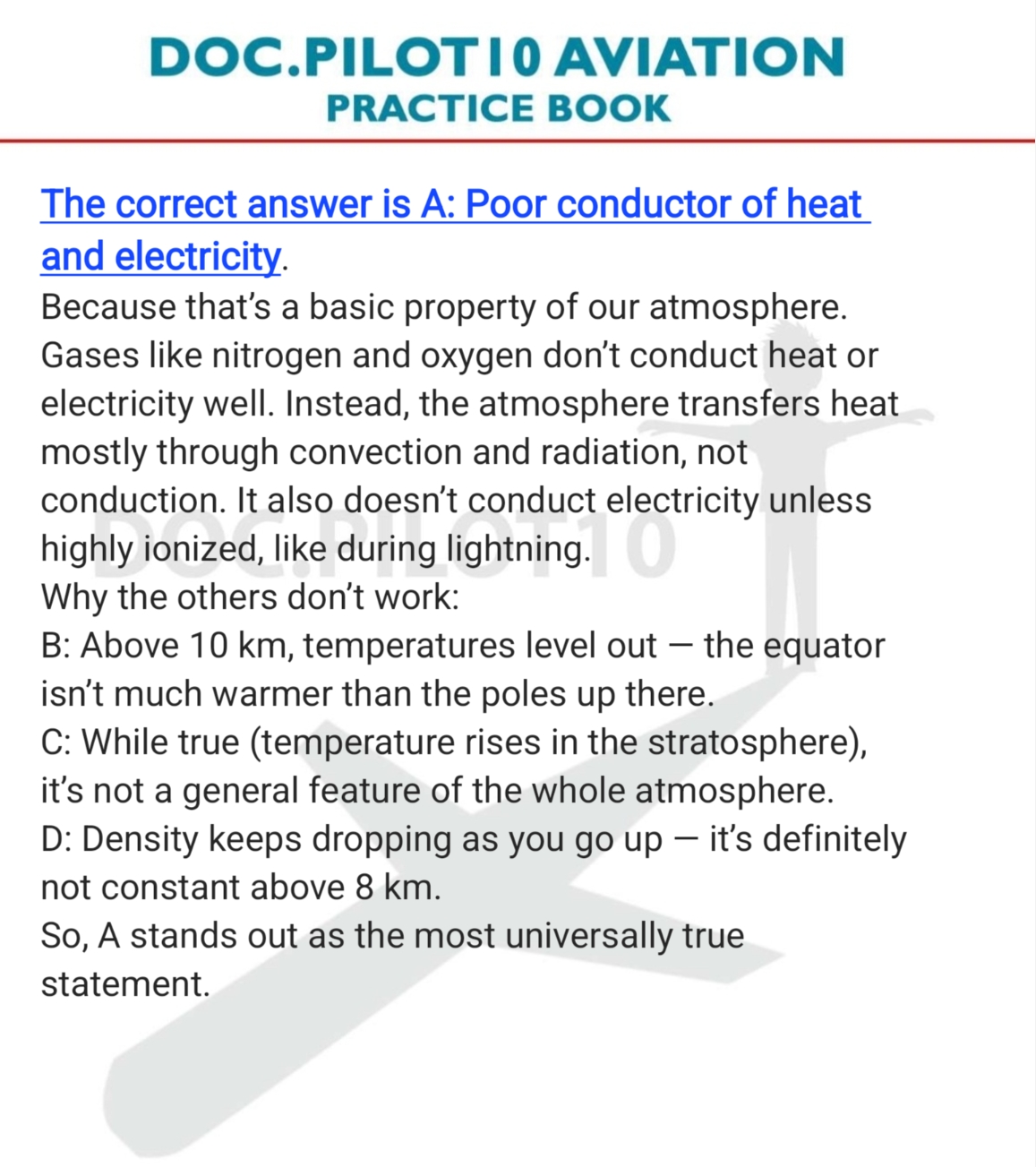 Air is a poor conductor of heat and electricity, so heat transfer is mainly by convection and radiation. The other choices are incorrect generalizations.
Air is a poor conductor of heat and electricity, so heat transfer is mainly by convection and radiation. The other choices are incorrect generalizations.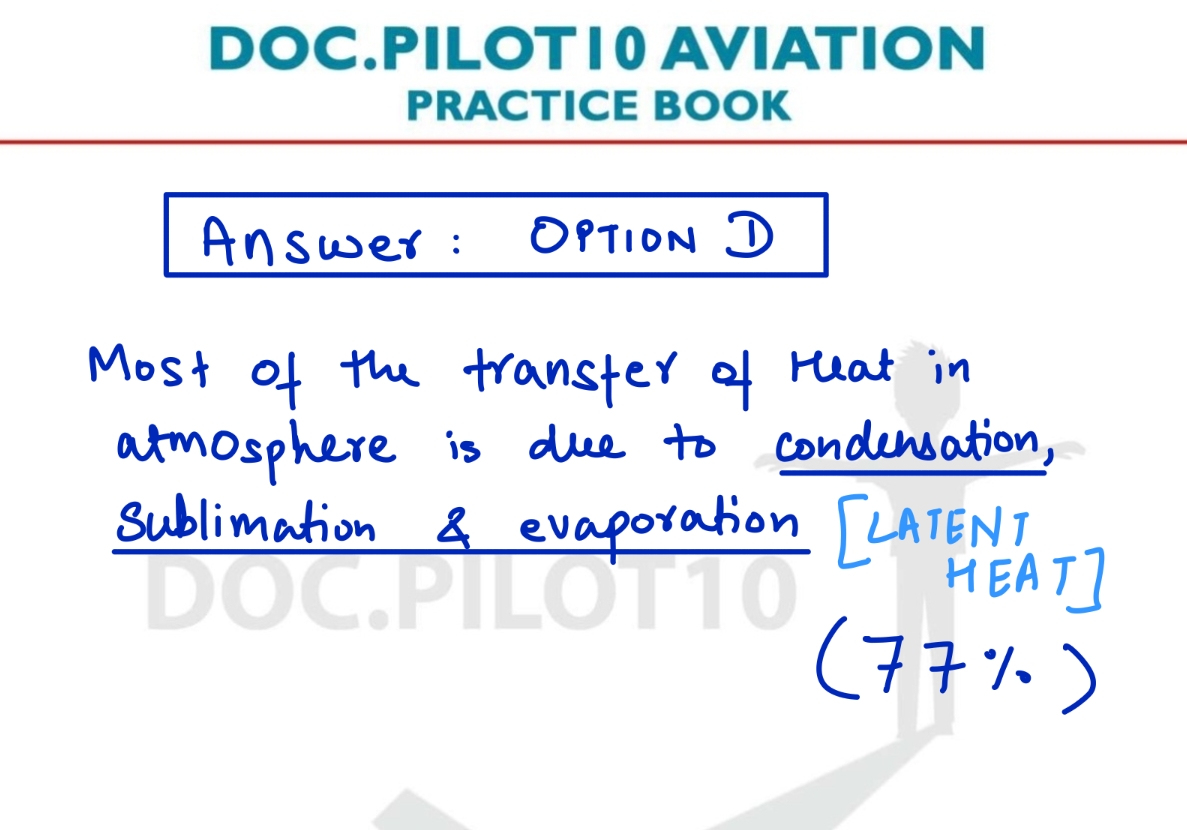 Latent heat associated with water phase changes (evaporation/condensation) transports large amounts of energy and is a dominant mechanism in atmospheric heat transfer.
Latent heat associated with water phase changes (evaporation/condensation) transports large amounts of energy and is a dominant mechanism in atmospheric heat transfer.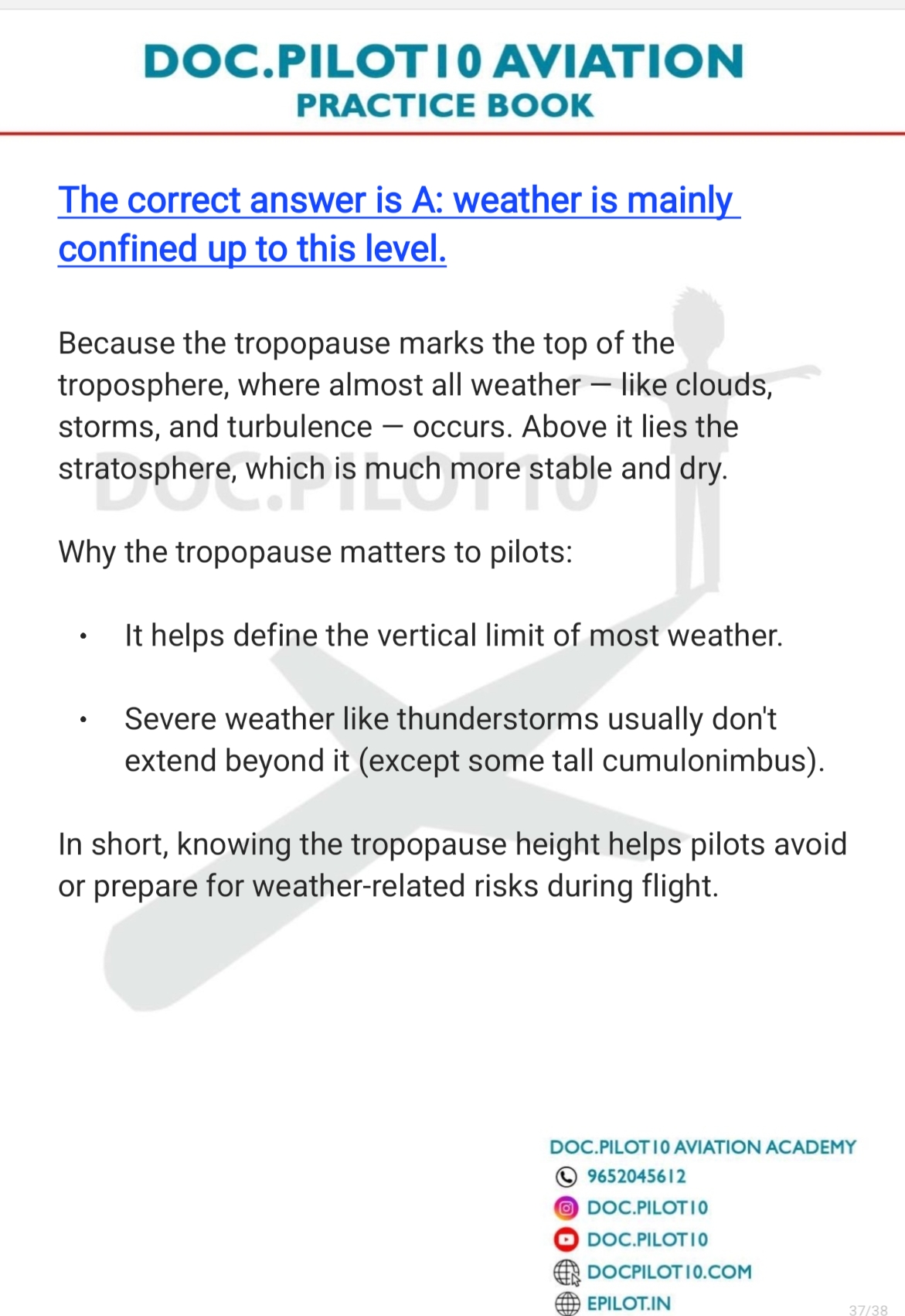 Most weather phenomena, including deep convection and turbulence, are confined to the troposphere below the tropopause; pilots use this to avoid convective tops and plan altitudes.
Most weather phenomena, including deep convection and turbulence, are confined to the troposphere below the tropopause; pilots use this to avoid convective tops and plan altitudes.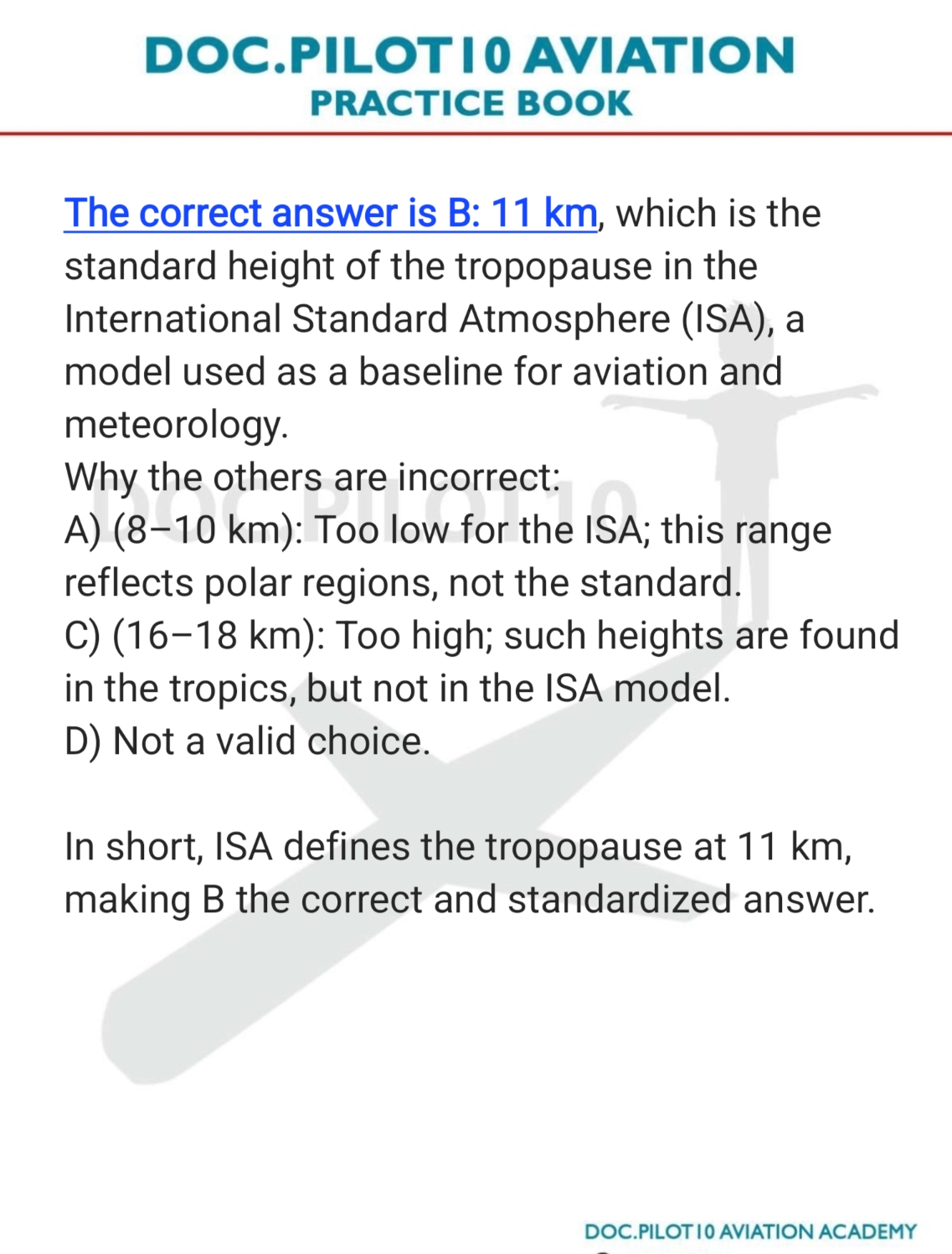 ISA defines the standard tropopause at 11 km. Actual tropopause height varies with latitude and season, but 11 km is the reference value.
ISA defines the standard tropopause at 11 km. Actual tropopause height varies with latitude and season, but 11 km is the reference value.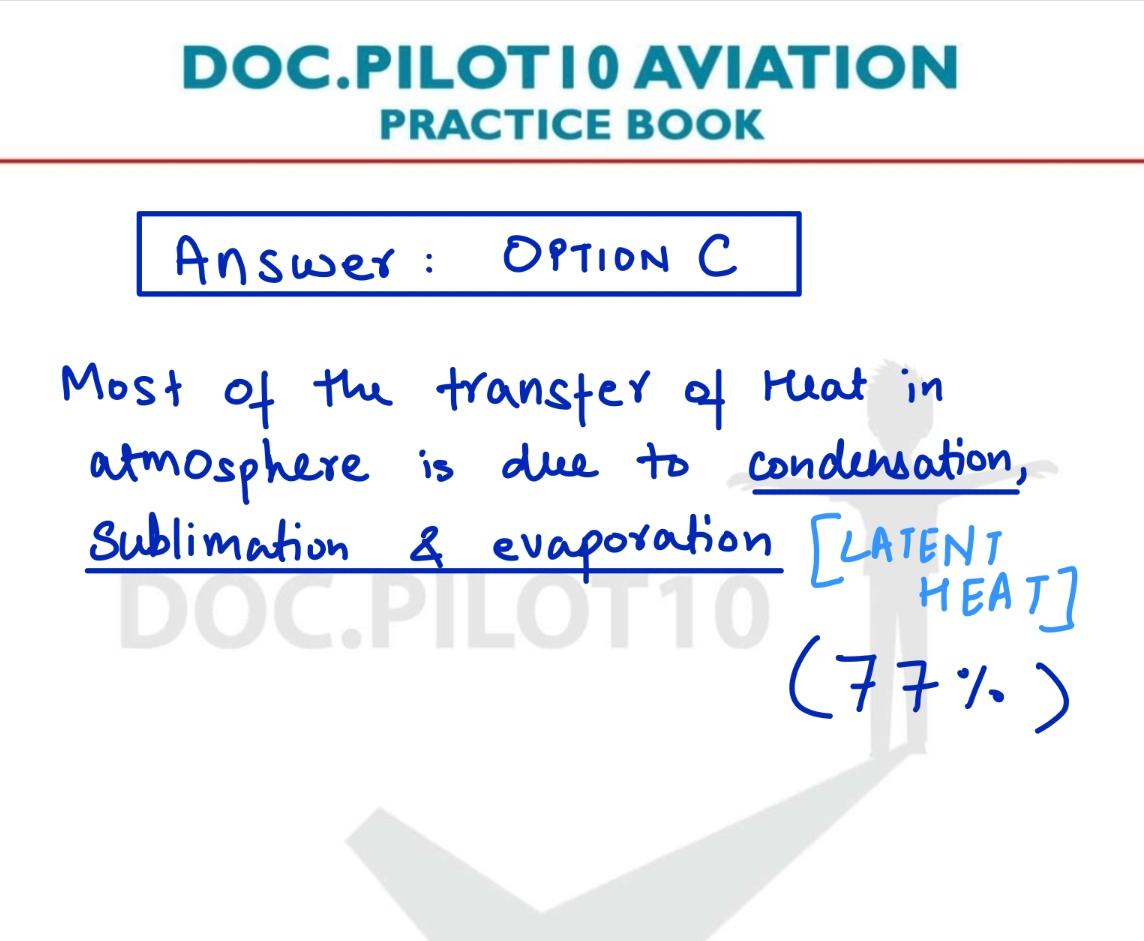 Convection and evaporation (latent heat) move bulk heat in the troposphere; conduction in air is weak, so bulk motion and phase changes dominate heat transport.
Convection and evaporation (latent heat) move bulk heat in the troposphere; conduction in air is weak, so bulk motion and phase changes dominate heat transport.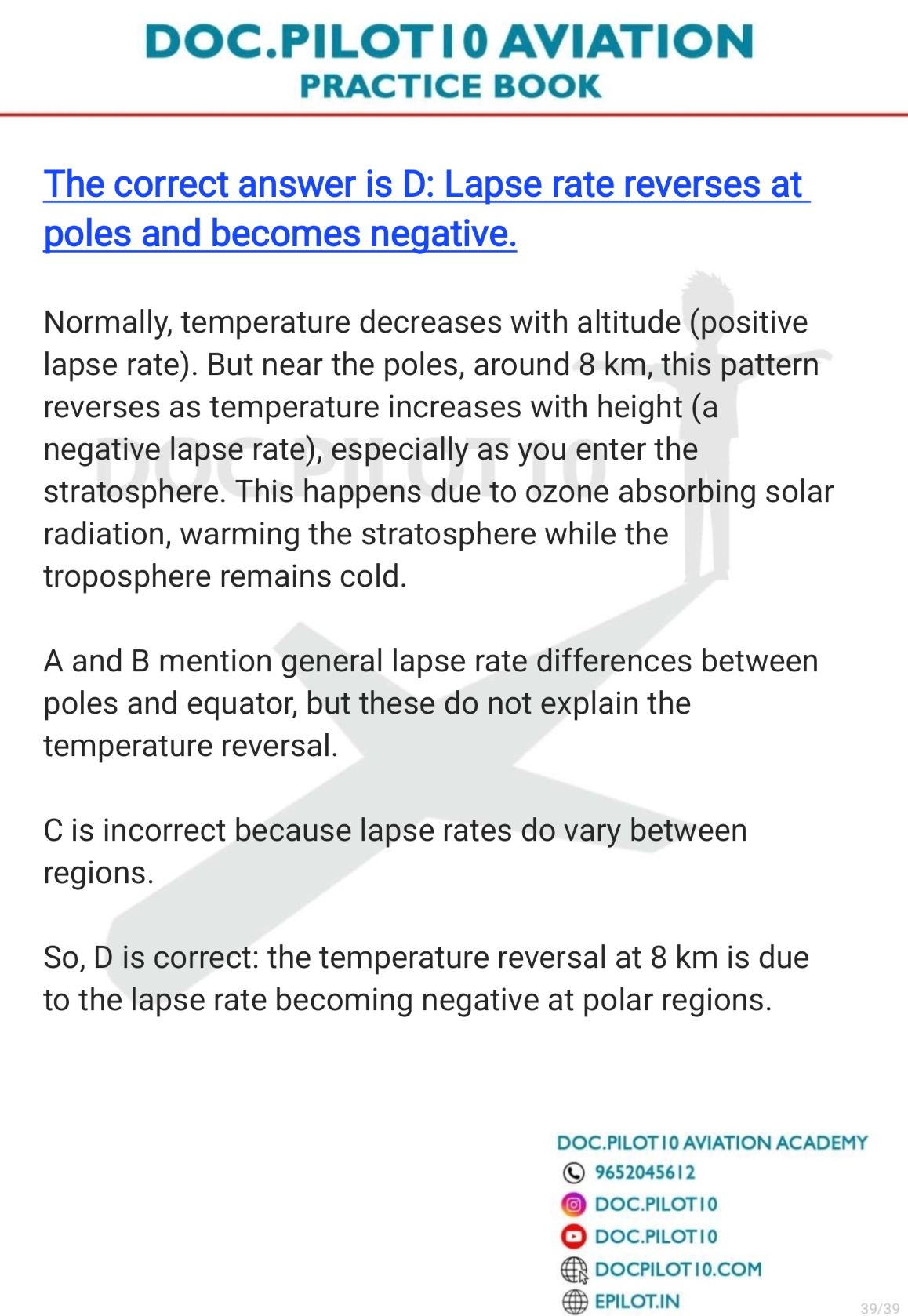 Near polar tropopause heights (~8–10 km) the lapse rate transitions to zero or negative (a stratospheric inversion), marking the shift from tropospheric cooling with height to warming with height.
Near polar tropopause heights (~8–10 km) the lapse rate transitions to zero or negative (a stratospheric inversion), marking the shift from tropospheric cooling with height to warming with height.

At Kerala Flight Academy, we are committed to providing exceptional aviation training. Join us to launch your career in the skies with expert instructors, state-of-the-art facilities, and comprehensive support. Your journey to becoming an aviation professional starts here!
Keralaflightacademy, Near Calicut International Airport 673647